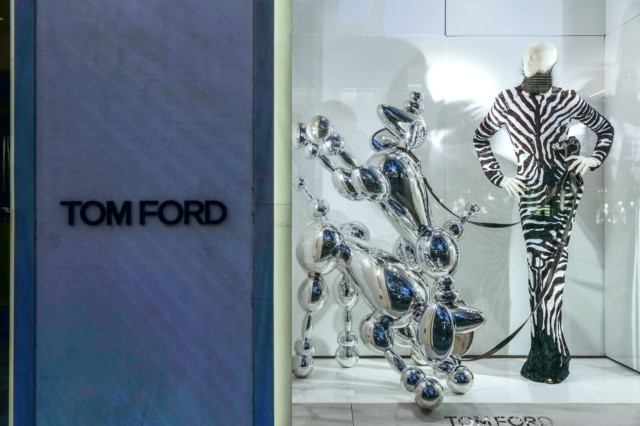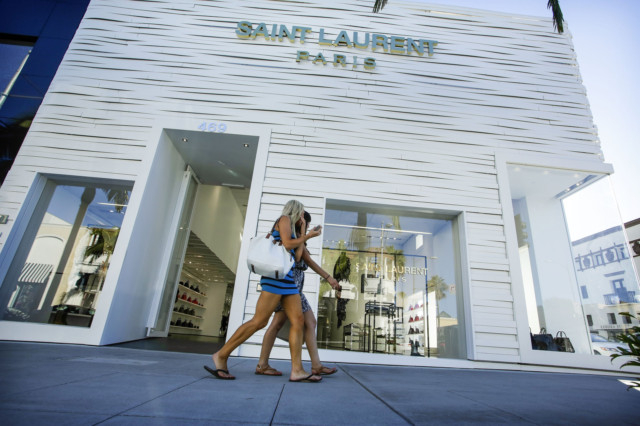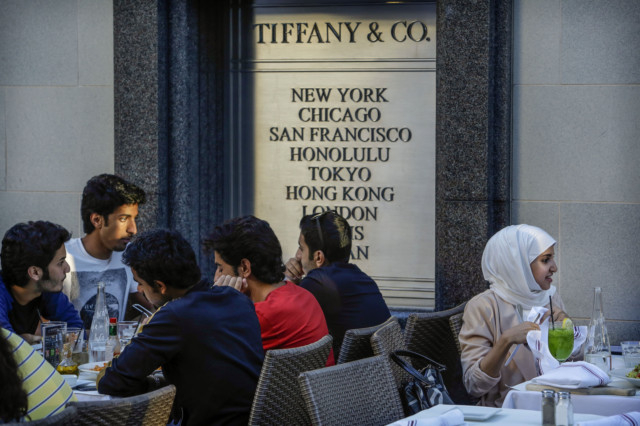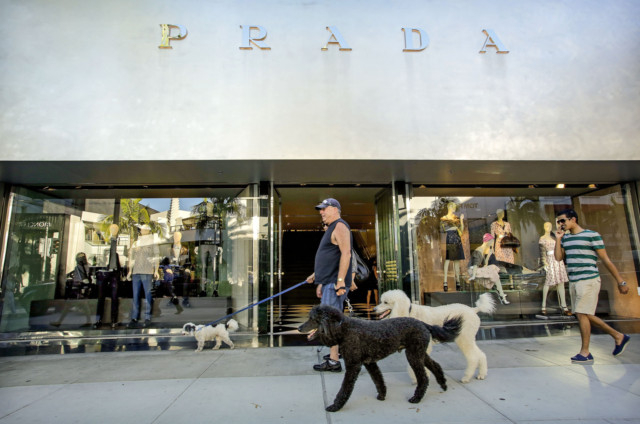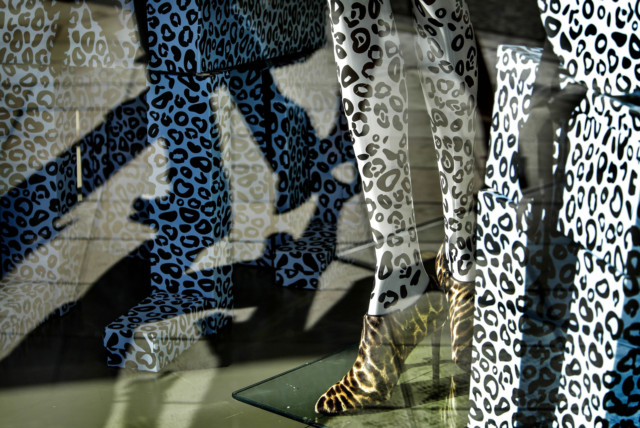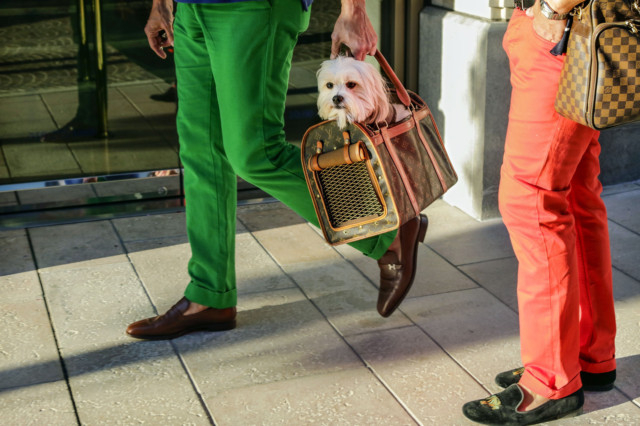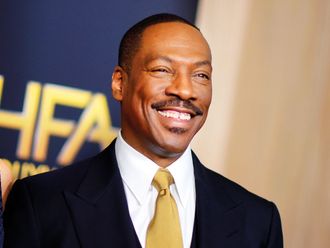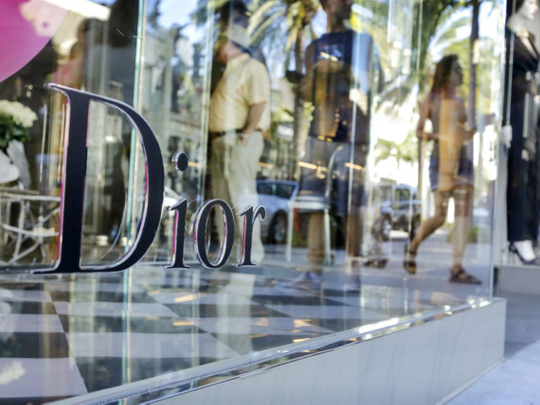
Sitting at the intersection of Hollywood and high fashion, it’s no wonder Rodeo Drive is one of the most fabled shopping streets in the world.
It’s been immortalised in movies, books, song lyrics and on reality TV.
The thoroughfare played a supporting role in the 1990 film Pretty Woman, when Julia Roberts went on a Cinderella-like shopping spree. Eddie Murphy flirted with a blond in a Mercedes on the same street in 1984’s Beverly Hills Cop.
Late August, Rodeo Drive was shut down for the elegant global pop-up dinner party “Diner en Blanc”, where 1,200 partygoers, fashionably dressed in white, mingled among the storefronts, further cementing the street’s reputation as LA’s luxury living room.
“Beverly Hills has gone from an exclusive enclave to a world icon,” says J.F. Lawton, who wrote the screenplay for Pretty Woman. “The film business has become more international, and that has contributed to the glamorous image of Rodeo Drive as a place where the rich and famous shop.”
“The stories of Steve McQueen and Grace Kelly going to Giorgio Beverly Hills in the 1960s and 1970s or Katharine Hepburn and Humphrey Bogart having dinner at Romanoff’s in the 1950s — Rodeo Drive is the epitome of glamour,” says designer Tory Burch, who is slated to open a $7 million (Dh26 million) Rodeo Drive flagship in November.
Today the street is in the midst of a renaissance that could very well ensure its supporting role in pop culture for years to come.
For the first time since the recession, there are almost no vacancies among the roughly 100 storefronts along the three-block retail row. On a recent afternoon, the crowds were thick, albeit with cameras outnumbering shopping bags and flip-flops outnumbering stilettos. Cadillac Escalades with blacked-out windows jockeyed for parking spots, as open-air Starline Tours vans with the tops cut off hugged the curbs.
“Look, it’s Jennifer Aniston!” a tour operator joked, pointing to an unsuspecting woman in front of the Michael Kors boutique who was most definitely not Jennifer Aniston.
The opening of a new Hermes flagship after an eight-month, $20 million renovation is just the latest in a flurry of development. From British shoe designer Charlotte Olympia’s first LA store, which opened in June at the top of Rodeo, to the new $5 million Celine boutique due south that’s stocking $3,000 trapeze bags, the luxury business appears to be booming.
“We went through this period after the financial crisis when everything stopped ... and a lot of the luxury brands put the brakes on development,” says Chuck Dembo, a real estate broker at Dembo Realty who handles a lot of luxury retail properties in the LA area. “Now they have started to invest in new infrastructure because luxury stores always have to update their look and keep it fresh. Their image is everything.”
It’s hard to say who was first. In October, Dior reopened its 5,000-square-foot store with a design concept borrowed from the brand’s worldwide flagship in Paris on Avenue Montaigne.
In November, Van Cleef & Arpels reopened its historic boutique by treating guests to a garden party and world premiere dance choreography by Benjamin Millepied. And this spring, Prada ditched its Rem Koolhaas-designed retail-as-cultural-epicentre concept in favour of a new, more inviting store.
Recent newcomers to the street include Patek Philippe, Pomellato, Stefano Ricci, Moncler, Vacheron Constantin, Barbara Bui and Frey Wille. Coming soon will be Vera Wang and Burberry. Meanwhile, Louis Vuitton and Saint Laurent are both embarking on multimillion-dollar renovations of their stores.
“With the Internet and social media and how important celebrity is to brands, being here is a must,” says Jay Luchs, Executive Vice President of real estate agency Newmark Grubb Knight Frank, who has handled many properties on Rodeo Drive.
“Celebrities are luxury customers too. And brands want them to have easy access. Because the minute someone famous wears something here, it goes around the world. By being on Rodeo Drive, they’re getting celebrities, locals and tourists.”
Another indicator of the value of a Rodeo Drive address is that luxury brands are starting to buy their stores instead of just leasing them. In May, Chanel bought 408 N. Rodeo in one of the highest per-square-foot sales in Los Angeles County, reportedly paying $117 million for the 13,317-square-foot property. LVMH Moet Hennessy Louis Vuitton bought 319 Rodeo for $85 million and Hermes bought its building for a reported $75 million.
“Those deals happened because those brands are looking at Rodeo as a long-term investment,” says Luchs, who worked on the Chanel and LVMH deals. He also noted that competition for leases has been heating up.
And while it may appear on a Saturday afternoon that there are more looky-loos on the street than high-end shoppers, the stores on Rodeo Drive are not just billboards for brands, Luchs says. “They want to do well, and if they don’t, they will leave.”
Pam Danziger, a luxury market researcher and founder of Unity Marketing, agrees. “Where they used to sell mostly through Saks, Neiman Marcus and other department stores, many luxury brands are now establishing more of their own solo branded stores,” she says. “There’s more profitability, and they’ve discovered they are the best equipped to sell their stuff.”
Rodeo Drive is also being bolstered by (and helping to bolster) development on surrounding streets. Beverly Drive has become a hot spot for contemporary brands. All Saints, Theory, Alice & Olivia, Intermix and Scoop recently opened there, and Maje, Sandro and IRO are coming soon. With the Wallis Annenberg Center for Performing Arts set to open in Beverly Hills in October, there are plenty of attractions to lure shoppers into making a day of it here.
“Brands came to the realisation that instead of trying to be different, they should go to a location where everyone is going to find them,” says Luchs. “Beverly Hills is back because it’s a place you’re going to get eyeballs.”
The evolution of a landmark
What follows are a few highlights from the history of one of the most famous streets in the world.
1906: Burton E. Green and other investors buy land on the former Rancho Rodeo de las Aguas. The land will become Beverly Hills, and the city’s main street is named ... Rodeo Drive. It eventually develops into and remains a fairly quiet suburban street with beauty shops, hardware stores, gas stations and bookstores for several decades.
1949: Former Warner Bros publicist Richard Carroll decides there’s no good place for a man to buy a suit in West Los Angeles. He opens Carroll & Co on the second floor of a Beverly Hills medical building. A few years later, Carroll & Co moves to the corner of Rodeo Drive and Little Santa Monica Boulevard.
1967: Fred Hayman opens the Giorgio Beverly Hills boutique. With its iconic yellow-and-white-striped awning, it’s the first high-fashion luxury boutique on the street and quickly becomes a civic landmark where customers can sip a cocktail while shopping or have their purchases delivered to their home by a courier in a Rolls-Royce.
1969: Parisian jeweller Van Cleef & Arpels — known for its commissions issued by European royals and prominent industrialists — opens a flagship store on Rodeo. Forty years later, the French jeweller acknowledges the influence of the Golden State as it launches “California Reverie”, a collection of one-of-a-kind pieces inspired by West Coast icons. (On the “Paysage d’Opal” clip, a large opal is the backdrop for two diamond palm trees, creating a brooch that is priced at about $350,000.)
1970: Vidal Sassoon opens a salon on Rodeo Drive, only his third worldwide. Three years earlier he had ensured a spot in the pop-culture pantheon — flying into Los Angeles from London to cut Mia Farrow’s hair for her role in Rosemary’s Baby. Farrow’s pixie cut was copied by women around the world.
1978: The novel Scruples by Judith Krantz is released. The book tells the story of a young widow who inherits a vast fortune and opens a boutique on — where else? — Rodeo Drive. The novel is a smash hit, and in 1980 Warner Bros Television produces a miniseries based on the novel.
1981: Hayman launches the Giorgio Beverly Hills fragrance. The launch party is held in Giorgio’s parking lot, under a yellow-and-white-striped tent. More than 32 kilograms of caviar are served.
1983: The Rodeo Collection shopping complex of 45 retail boutiques opens. The next year, it is featured in the Brian De Palma thriller Body Double. Present stores include La Perla and Stuart Weitzman.
1984: In Beverly Hills Cop, one of the first things Detroit policeman Axel Foley (Eddie Murphy) does upon arriving in Beverly Hills is drive down Rodeo Drive. When Axel flirts with a blond in a convertible, moviegoers get a glimpse of the Cartier boutique.
1989: The European-style shopping street Two Rodeo Drive opens. The present lineup of stores includes Lanvin, Versace, Jimmy Choo and Tiffany.
1990: In the film Pretty Woman, a “beautiful prostitute” (Julia Roberts) goes shopping on Rodeo Drive and is snubbed by salespeople who are dismayed by her appearance. The next day her “client” (Richard Gere) sends her out on a shopping spree, eventually returning to the shop that snubbed her to remind the clerks of the purchases they could have overseen. Shopping binges in the movies would never be the same.
1990: In Beverly Hills 90210’s third episode — Every Dream Has Its Price (Tag) — Brenda (Shannen Doherty) and Kelly (Jennie Garth) go shopping on Rodeo Drive with Kelly’s old friend Tiffany (Noelle Parker), but drama ensues when the girls learn Tiffany is a shoplifter.
1993: Guess opens the Western-themed Guess? Ranch, the first “down-market” store to open on Rodeo Drive. Other brands more associated with shopping malls than high couture will open shops on the street.
2004: Prada opens a boutique designed by noted architect Rem Koolhaas.
2012: High-end timepiece manufacturer Patek Philippe opens its first boutique in the United States on Rodeo Drive. In the same year, the 99 Cents Only Store proposes opening a store on Rodeo Drive. Other tenants on the storied street are less than
Los Angeles Times



